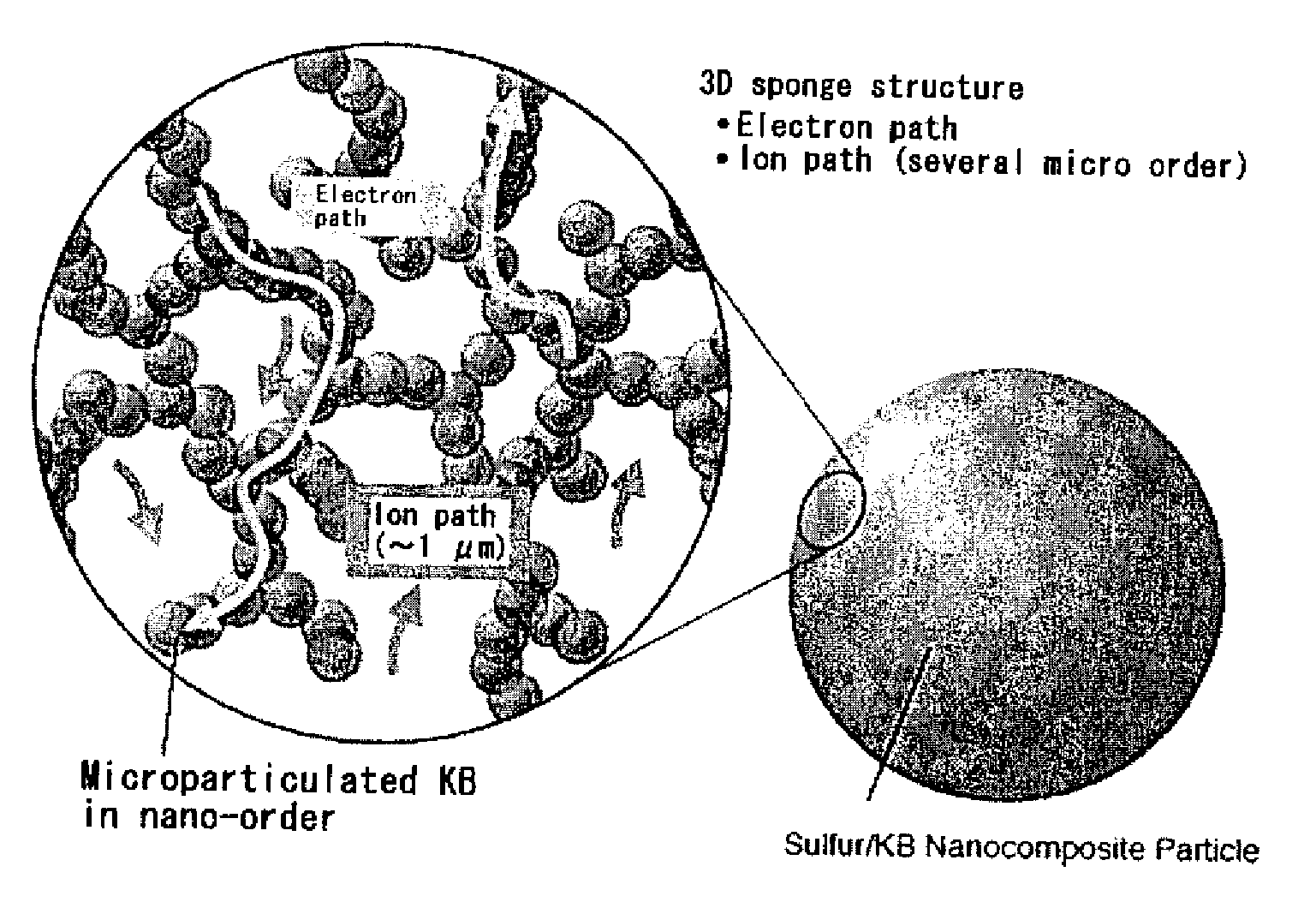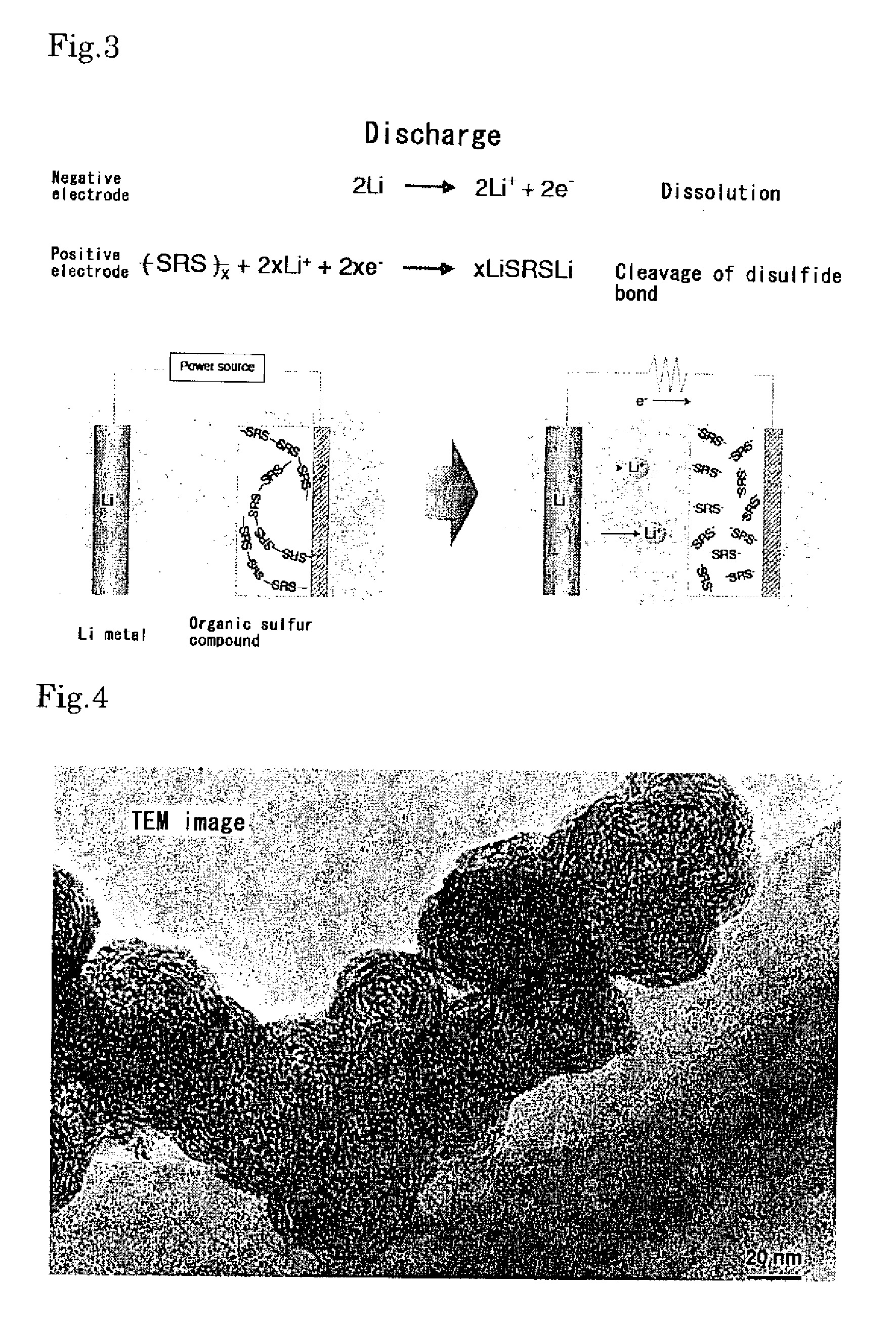Battery Positive Electrode Material Containing Sulfur and /or Sulfur Compound having S-S Bond, and Process for Producing the Same
- Summary
- Abstract
- Description
- Claims
- Application Information
AI Technical Summary
Benefits of technology
Problems solved by technology
Method used
Image
Examples
reference example 1
Production and Identification of Composite Substance of Sulfur and Ketjen Black, which has Composite Microparticle Layer where Microparticles of Ketjen Black are Intruded into Particles of Elemental Sulfur
[0111] In Reference Example 1, a mechanochemical bonding (MCB) process was used as a process for uniformly coating a nano-size thin layer of Ketjen Black around the sulfur-based compound. As shown in FIG. 23, the mechanochemical bonding process has an effect of producing a bond and a composite state close to a chemical bond by utilizing mechanical and physical forces. The combining technique by the mechanochemical bonding process is able to produce composite particles with strong bonds among nano-size particles by the action of excitation energy newly applied.
[0112]FIG. 31 shows a mixture ratio of the elemental sulfur to Ketjen Black when the Ketjen Black is coated around the elemental sulfur by the mechanochemical bonding process. More specifically, FIG. 31 shows a weight ratio ...
reference example 2
Production and Identification of Fibrous Intermediate Composite Substance
[0126]FIG. 13 shows one example of a process for producing the fibrous intermediate composite substance. The composite substance (B is used herein as one example) is heated to 160-165° C. By holding the temperature of 160-165° C., the composite substance is brought into a fluidized state. The composite substance B in the fluidized state is stirred and elongated. After elongating the intermediate composite substance B in the fluidized state, it is cooled to the room temperature. The surface and cross-section of a formed fibrous intermediate composite substance B′ are observed using a scanning electron microscope. Further, the formed fibrous intermediate composite substance B′ is pulverized and resulting particles are observed using the scanning electron microscope.
[0127]FIG. 14 is a photo (×200) of the fibrous intermediate composite substance B′, which was taken using the scanning electron microscope (SEM). Th...
example 1
[0138] In this Example 1, a comparative test of discharge capacity was made on a positive electrode A made of a composite substance of sulfur and conductive carbon black and produced by the mechanofusion, and a positive electrode B made of the same materials and produced by the wet process.
Materials Used
[0139] Each of the positive electrode A and the positive electrode B contained 72.9 weight % of sulfur and 27.1 weight % of carbon microparticles. Commercially available Ketjen Black was used as the carbon microparticles of the positive electrode A. Most commonly used acetylene black was used for the positive electrode B.
Production of Positive Electrode Materials
[0140] The positive electrode A was produced, as shown in FIG. 23, through the steps of loading the sulfur and the carbon microparticles into a rotating container, and applying strong shearing forces, compression, and breaking stress to the loaded materials between an inner roll and a wall surface of the container, thereb...
PUM
| Property | Measurement | Unit |
|---|---|---|
| Percent by mass | aaaaa | aaaaa |
| Percent by mass | aaaaa | aaaaa |
| Electrical conductivity | aaaaa | aaaaa |
Abstract
Description
Claims
Application Information
 Login to View More
Login to View More - R&D
- Intellectual Property
- Life Sciences
- Materials
- Tech Scout
- Unparalleled Data Quality
- Higher Quality Content
- 60% Fewer Hallucinations
Browse by: Latest US Patents, China's latest patents, Technical Efficacy Thesaurus, Application Domain, Technology Topic, Popular Technical Reports.
© 2025 PatSnap. All rights reserved.Legal|Privacy policy|Modern Slavery Act Transparency Statement|Sitemap|About US| Contact US: help@patsnap.com



